Interesting Stuff
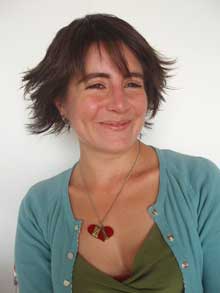 Last month i was in Colombia for (and thanks to) the Pixelazo festival.
Last month i was in Colombia for (and thanks to) the Pixelazo festival.
I then asked Alejandro Tamayo if he could point me to any artist worth meeting in Bogota. Several names came to his mind but when i had a look at the images of Adriana Salazar's machines, i just said "Stop! Stop! no more names, how can i get to meet her?" How could i not want to know more about a girl who creates delicate and elegant (but slightly ludicrous) machines that smoke, tie shoes, pull thread through the hole of a needle, relentlessly measure walls, switch the light on and off, on and off, on and off, dust walls, cry while another one dries its tears, etc.
What is your background? How did you start creating machines? Is "machine" the correct word to describe them by the way?
I studied fine arts at the Jorge Tadeo Lozano University, here in Bogota. At the very end of my career, just when I was starting to develop my last academic project, I came to the encounter of moving devices, by chance, or maybe because I just couldnât stand stillness. After that I decided to work with a more specific kind of movement: human actions that are performed repeatedly and without any awareness of what happens to the body meanwhile. I started thus with smoking, as an action with a very complex body movement involved. The idea of isolating this action, from its context, resulted in a sort of âmachine-like objectâ, but with the exact opposite functions a machine would usually perform: it just had no purpose, no practical value. Besides, the object that resulted was rather clumsy, simple and almost hand-made, so there is no fancy technological operations involved, and no industrial mass-produced object as a result of the process. The word machine seems then incorrect, in that sense.
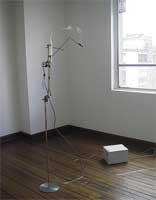

Mademoiselle, Máquina fumadora (Smoking machine)
What fascinates you in the absurd and the useless?
The fact that it is precisely through the absurd and the useless that we can really get to understand what us humans are like: we can perform coherent and beautiful actions that still have no purpose. The purpose of our actions, or even better, their ends, somehow always escapes our comprehension, and yet we keep moving and doing things. It is fascinating then to see, as in a distorted mirror in front of us, what we do, but without our presence: just the action repeating itself over and over.
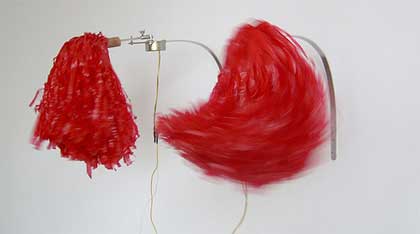
Porristas
What is your relationship with the machines you create? Do you see them as mere objects for galleries or do you develop a more personal relationship with them?
There is something I really like about them: Their design is always the result of very simple mechanical or physical processes, and it is conceived by the mind of an amateur: There is no engineering or high-tech involved. The result is therefore a very personal interpretation of a movement, so it turns to be more an expressive device than a robot or an automatic appliance.
On the other hand there are a couple of pieces that work very well with galleries, but not because they look good in them or because they are commercial. Both the smoking machine (Mademoiselle) and the careless machines (the ones that start making a toast, and end up drunk and unsynchronized) invert the social roles of the actors in an exhibition opening: When the guests drink and smoke while looking at the art pieces, these two art pieces drink and smoke while looking back at their beholders.
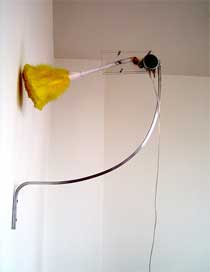
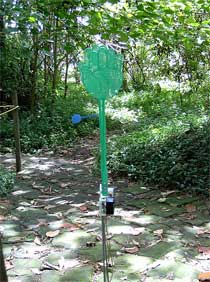
Máquina desempolvadora and La desaparición de las necesidades
How do you develop them? On your own? or do you collaborate with someone else to build up the technical elements?
The whole process of designing and building these objects is rather interesting. I am becoming first of all very comfortable with the fact that they are created in sort of a naïve way. I need to understand what is going on in there, and I need the viewer to do so too, so I tend to avoid complex operations or technological novelties that could leave you just amazed and overwhelmed. Nevertheless, I have always had the support of people that obviously know how to do certain things better than me, especially concerning working with metal or other industrial materials that require special instruments. The rest is just small disco ball motors working!
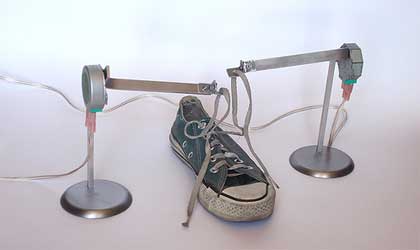
Máquina que intenta amarrar un zapato (Machine that tries to tie shoes)
Are your works a comment on technology, human beings or their relationship to technology? Maybe all of those?
Certainly all of those. I am not a moralist towards technology, but I love to show its ironic side, I love to laugh at the fact that we truly e truly believe technology is progress, and that it is eventually going to save our lives: in my pieces there is always something that remains incomplete, some sort of imperfection that becomes an effective part of the work. It is as if our actions as well as our machines were always failing to succeed their task. Maybe what humanizes our technological world isnât its tendency to boost human form or function, but its constant failure, its fragility.
There is in fact one of my pieces that is actually a âtrying machineâ, a machine that makes an effort and always fails (machine that tries to thread a needle): it is small, modest, and stubborn as a man.
Is there any artists that has influenced you or that you particularly appreciate the work of?
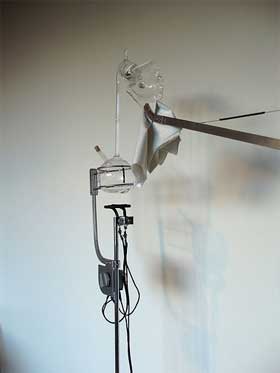
I know I should probably be bringing influential figures here, such as Rebecca Horn or Jean Tinguely, or even Stelarc or Wim Delvoye. I discovered that the artists I love the most are those who are completely alien to my processes and those whose work is most disturbing and uncomprehensible. In the research process for my last piece âlloronaâ (crying woman), for example, I rediscovered some fascinating Man Ray pictures, and I fell in love with Hans Haackeâs Condensation Cube. I also truly related to this last piece in the sense that it is very complex, theatrically complex almost, and at the same time it is the simplest thing of all!!!
What is the reaction of the public when they see your art pieces?
Iâve seen all kinds of reactions. I like the fact that this kind of things tend to escape the discursive, enclosed, and elitist approach to contemporary art. I like, for example, when people laugh at them or when they become interested in how they work or in how they relate to certain human experiences. I had once a group of industrial design students that came with a very unexpected and interesting approach, from the designerâs point of view. I had never thought of my work as design, but I understood that definitely design played a very strong role in it: The human being is able to redesign its body and modify it to perform a certain function, and artists are mostly perception and body designers. I owe this discovery to the input from the public.
Thanks Adriana!
All images courtesy of Adriana Salazar.
- Ananova - Nappies for donkeys
Donkey owners in a Kenyan town are up in arms after officials ordered their animals to wear nappies. - WE NOT/ FLICKR + WORDNET / GREGORY CHATONSKY / 2006
Flickr and wordnet hack to create new sentence "we...not..." - Defunktion©
Ferguson entangles embroidery with technology fetishism creating stunning and unexpected imagery. - The worst art show ever - Telegraph
This is a show organised by two pseuds and intended for graduate students and people who don't really like visual art at all. - Four inmates have been accused of trying to use copyright law to escape.
They allegedly copyrighted their own names and then demanded millions of dollars from jail officials for using them without permission
- Digital Arts Week in Zurich - a report from Anna Dumitriu
- documenta12: kalender_inhalt
me in documenta. with text a bit over the top cuz written by over kind alessandro - [esferapública] - inicio
Portal donde se encuentran los resúmenes de las discusiones, asà como artÃculos de sus participantes. Dispone de herramientas para convertir los documentos a PDF, imprimirlos o enviar su enlace por correo electrónico. La lista de correos distribuye la - pasta and vinegar » Gaming in South Korea
great forecast article by Jeff Yang about MMO evolution and South Korea. - New Scientist Technology Blog: The Curious Home
video about an exhibition by designers from Goldsmiths: - Thermocline of Art. New Asian Waves :
117 artists representing 20 Asian countries from the Middle East to Far East, from Southeast Asia to Near East and Central Asia, offers the first comprehensive picture of contemporary Asian art production.
Humans walking on two legs consume only a quarter of the energy that chimpanzees use while "knuckle-walking" on all fours, according to a new study.
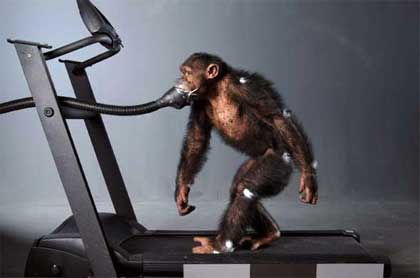
Via 20 minutes and New Scientist.
On Friday 13 i spent an extra day in Huddersfield to attend the Biorama organized by Capsula and the Digital Research Unit. The objective was to illustrate new directions in art, science and technology by bringing together artists who explore notions of life, science and digital realities.
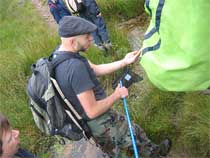
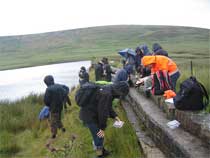
Biorama also puts the research carried out by Andy Gracie (whom i interviewed a while ago) during his 3-month residency at DRU into a broader context. His project weaves together the microbiology of the Pennines around Marsden Moor, traditional and digital networking systems, satellite communications, perceptions of landscape and the history and possible future of interstellar communication.
During the morning we went for a long but extremely fun hike under the rain. We followed Andy and Brandon Ballangee, looking for frogs, getting the lowdown on the nematodes, collecting samples, and watching organisms under the lens of our pocket microscopes. Searching for things we can't see and that crawl under our feet and trying somehow to connect them with what we cannot see either because it is way too high above our head.
In the afternoon, we headed to the DRU and the artists' talks kicked off with Andy's presention of his work, this time it was dry, we sat on chai on chairs and there were plenty of snacks on hand. Part of his research investigates communication with living forms we might yet not have encountered. Previous attempts to communicate with them include:
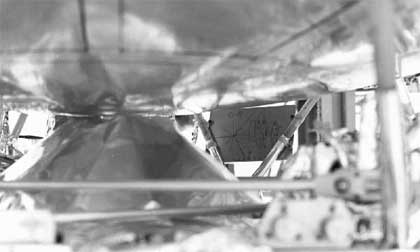
The Pioneer Plaque
- the Pioneer Plaque, on board of the unmanned spacecraft Pioneer 10 and Pioneer 11, displays a pictorial message from mankind. The figures and symbols are designed to provide information about the origin of the spacecraft. It serves as a kind of interstellar "message in a bottle".
- the Voyager Golden Record, included in the two Voyager spacecraft launched in 1977, it contains sounds and images that portray the diversity of life and culture on Earth. It is intended for any intelligent extraterrestrial life form, or far future humans, that may find it.
There is also the hypothesis to discover microbial life somewhere in our solar system and thus the desire to communicate with them. Some serious issues are at stake, such as nuclear waste dumps. How do you warn people not to dig it up for another 10,000 years? There is a high probability that our current form of civilization wonât be around in 12000AD so a simple âDanger, Keep Out!â may not work. Think about Stonehenge, it is relatively not that far away back in time, yet we still haven't got much clue on what the construction means.
The U.S. Department of Energy has been recently looking at this issue and wondering what to do about the warning markers at the Waste Isolation Pilot Plant (WIPP) at Yucca Mountain. Various plans have been proposed such as making it a big spikey forboding landscape.
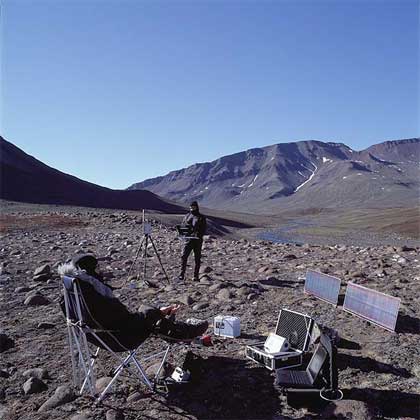
photo credit: Anthony Oliver
After Andy, artists were invited to take the floor. Starting with London Fieldworks. Bruce Gilchrist & Jo Joelson are interested in human relationship with the natural environment, their work tends to bring elements of the landscape (mostly from rather extreme environments) into an urban context.
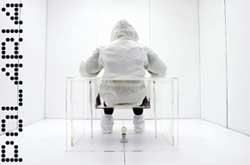
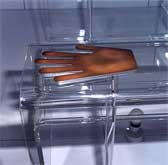
For Polaria they collected data about light and physiology during the transition from 24 hour daylight to the twilight onset of winter in North East Greenland and brought the data back into a studio and translated it into a virtual daylight installation. They left the data open for the public to interpret it.
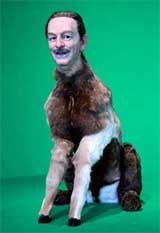 The Little Earth installation consisted of synchronised video shot on Haldde Mountain in the Norwegian Arctic, Ben Nevis in Scotland, and on the island of Svalbard, with computer animations of the Earthâs magnetosphere modeled by the Leicester Radio & Space Plasma Physics Group, the science partner in this arts/science collaboration. The video, shot from 4 perspectives is projected onto a suspended cube-like structure, with a surround sound score and narration.
The Little Earth installation consisted of synchronised video shot on Haldde Mountain in the Norwegian Arctic, Ben Nevis in Scotland, and on the island of Svalbard, with computer animations of the Earthâs magnetosphere modeled by the Leicester Radio & Space Plasma Physics Group, the science partner in this arts/science collaboration. The video, shot from 4 perspectives is projected onto a suspended cube-like structure, with a surround sound score and narration.
London Fieldworks is currently working on Prince of the Petrified Forest. Working with the personal myth of Walt Disney, cryogenically frozen at the point of death, the artists proposed to reincarnate him into an animatronic Hexer alter-ego (image) which would star in their film Prince Of The Petrified Forest - part inspired by the seminal eco novel, Bambi by Felix Salten and Prospect of Immortality by Robert Ettinger, "the father of cryonics" but also by stories read in the press such as the one of the mouse put in 'suspended animation'. The themes of the movie are hibernation and suspension.
The animatronic is a monstrous hybrid of Disney and his iconic characters, Bambi and Thumper.
SpaceBaby, supported by art science agency The Arts Catalyst, explored inverted sleep pattern and its possible effect on human genes, referencing research interest of space agencies into human hibernation. The artists slept through the day in specially constructed "hibernaculum" and scientists from the University of Leicester Dept. of Genetics were taking blood samples to monitor the effect the reverse sleep pattern had on their genes. The project will be turned into a film.



SpaceBaby, just like the Disney chimera project, made reference to recent scientific experiment into the induction of suspended states of animation in non-hibernatory animals. The project imagines space agencies transferring these applications to humans to facilitate long distance space flight. C-lab has some more images of the installation.
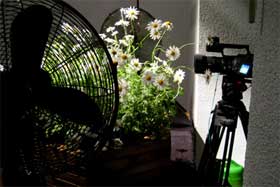 Project number 4* developed over the Interactivos? workshop at the MediaLab Madrid last month.
Project number 4* developed over the Interactivos? workshop at the MediaLab Madrid last month.
That one appealed to me a lot while i was visiting the workshop. All those daisies among just chips, broken bulbs, circuit boards, bits of cables and plastic!
I Thought Some Daisies Might Cheer You Up, by André Gonçalves, reacts to the displacement of the air that moves with us. Using people's movement in the space, the installation simulates unnatural forces, in a poetic sense.
The room is divided in two parts. In the first half a computer vision system tracks user's movement, direction and velocity; fans are activated via an Arduino board. If someone passes in a certain direction only the corresponding fan would be activated, the faster the movement, the faster the fans spin.
In the back room, there is a flower bed of daisies, leaving space for people to walk around it. In front of the flowers a camera captures video and sends it to the projector. The projection shows an image of the flower bed bending with people's motion.
What inspired the idea behind *"I thought some daisies might cheer you up"?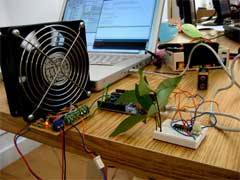
This installation have been in my mind for a couple years, at the time i was in residency at Experimental Intermedia Foundation in NY, so sometimes i liked to feel like a tourist and walkaround the city, that day i had in mind walking all the way down central park starting from Harlem, so at some point i climbed one hill and, without expecting it, i was facing the Jacqueline Kennedy Reservoir and i was instantly overwhelmed by that huge amount of water, itâs location and itâs surroundings, it instantly gave me the shivers! That state of conscience induced by the place itself made me enjoy the moment in a very emotional way. While holding that feeling i found myself watching the canes that grow on the shore, they were bending due to strong winds and they were making a really loud noise, i remember ignoring my skin senses and just imagined what if it wasnât the wind that were bending the canes but, instead, sound itself. As if the sound was coming from somewhere else and when passing by those canes it was making them bend more or less accordingly to itâs amplitude, like if they were crouching, trying to hide from sound strength or performing choreographed movements with the sounds heard. After that i just wanted to explore how sound could be used as a movement inducer in order to recreate that experience and at the same time it triggered in me this idea of how to make a spectator believe in a not so natural behaviour when presented as a natural one.
The main difference between the finished work and the initial idea is the use of movement replacing sound, as if the air that we force to move when we move could have an effect on real objects, in a poetic sense it's a tremendous amplification of our mass dislocation air-flow movement, the air that moves along with us.
The other difference is the subject to control, instead of canes i knew i wanted a flower, but it had to be as fragile as poetic, i instantly remembered of daisies for being the most simple and beautifull wild flower, at the same time i remembered this line from the song âDaisies of the Galaxyâ by Eels, where Mr. E(?) was picking up daisies for a friend in need, taken out of the context i like to keep in open who i really wanted to cheer up, a loved one, interactivos?, myself...
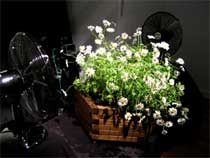
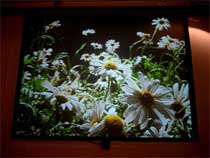
What was the biggest challenge in developing the project?
Definetly everything related with the control of the natural factor involved. As funny as it may seem, in the beggining of the development, the biggest problem appeared to be finding the proper daisies, although it was spring time flower shops in town only had one or two specific kind which didnât suit because they were too big and hard to bend with the wind forces applied, fortunatly i had a big help from Gema e Paola, my always so kind volunteer collaborators, so they took me outside Madrid to a green house where they had all sorts of flowers, plants, vases, and got that sorted out, but then i faced one of my most important concerns, how to keep itâs âreality-nessâ, the idea of controlling nature forces always seems very easy in sketches but, as in other of my experiences, the response is as surprising as it is not linear.
Because of that the biggest part of the time was spent in testing, testing, testing and testing it again, changing all the parameters that i could think of so to achieve the best settings for the the overall effect, also i had to look for fans that could bring the most to the installation, both in technical and aesthetic aspects, had to find the best position, the rotation speed, the hardware reaction factor, all this done with the time constraint flashing above, somewhere.
Do you plan to develop the idea any further?
Yes, this specific piece i would love to present it in a larger scale in a different setting where the installation, instead of two contiguous rooms, would be separated by a gallery window so that the first room would be the gallery sidewalk, reacting to the outside environment.
But what mostly interested me from the very start was having wind as an output of a whole system with the purpose of controlling a third element by a certain magical invisible force.
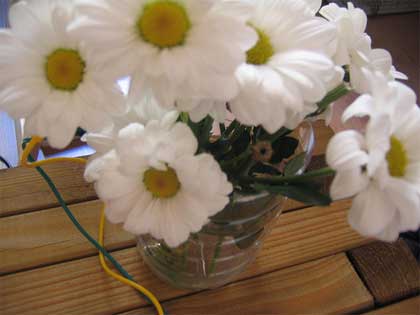
Work in progress
Since i left Madrid i have already made two new pieces using wind as a controller for physical events, both of them are exploring this in different directions but at the same time both are taking advantage of this poetic use of wind forces.
The first of them is a continuous levitation of a balloon, where one fan is faced up and a balloon located over it, the fan speed reacts to the sound amplitude of a chosen source so that the higher the volume the higher the balloon floats, iâve been using it as a real-time video installation for my solo musical performances, but iâve also been working on a bigger and standalone version...
The second is a collaboration with Pedro Boavida, a friend whoâs also a musician, we were invited to play in this big one night event happening in Lisbon and we wanted to make something that could also work as an installation, after several days of brainstormings and experiments we ended up with this setup that consisted in five guitars, five fans, a sound mixer and some amplifiers, the guitars laid on the floor with the fans attached over the first fret blowing in the guitarâs body direction, both the wind and the fan vibration over the strings cause each guitar to resonate creating a soundscape based in the guitars tuning and the performance space resonant properties.
Both projects can be seen in my website in more detail.
Thanks André!
* Delicate Boundaries, Palimpsesto and Augmented Sculpture v 1.0.
See also Dandelion by Sennep, Sommerer & Mignonneau's Interactive Plant Growing.
- New World Notes: THIS IS TRULY CHINA TRACY
Interview with Cao Fei who became a mixed reality artist in SL, roleplaying as an avatar and making a film of her experiences there - Starbucks closes coffeehouse in Beijing's Forbidden City
"ending a presence that prompted protests by Chinese critics who said it damaged a major historical site." un de moins! - Conversazione con Eduardo Kac - Maurizio Bolognini
Bioestetica, arte transgenica e il coniglio verde. Conversazione con Eduardo Kac - Boing Boing: Russians have fun with video of "Big-Eyed Guy"
my kind of humour. makes me laugh out loud. hey! one does not get much fun here at documenta - Boing Boing: Mystery creature phature photographed in Seattle -- a kangahippomouse?
- YouTube - Discovering Electronic Music Part 1
educational film from 1983 describing a little bit of the history and tools of electronic music. (via neural) - Networked_Performance — "Our Biotech Future" by Freeman Dyson
Biology is also more important than physics, as measured by its economic consequences, by its ethical implications, or by its effects on human welfare.
I have only seen two of the exhibition spaces of Documenta 12. Many wrote how bad the show is and of course i am doing my best to disagree and find some beauty here. There is some. Well, there's the ueber sexy Harvey Keitel asking 'Why are we here?" in a video artwork by James Coleman. But apart from that, so far, so not exciting.
The exhibition at the Documenta Hall is quite fun, in a kindergarten way. There are stuffed animals everywhere you look (i also witnessed an amazing amount of stuffed baby Knut all over the city btw.)
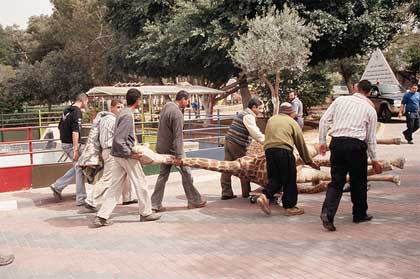
Real one first, a taxidermized giraffe which artist Peter Friedl brought back all the way from Qalquilyah, host of the only zoo in Palestine.
In spring 2003, the city was attacked and fired on by the Israeli army during the second Intifada. As a result, many animals were killed, including the above mentioned giraffe. During a shelling Brownie (that's the name of the animal) panicked, hit its head on a pole, fell and died. The veterinarian became a taxidermist, who stuffed Brownie among others in an amateur manner. The conserved animals were displayed in a âmuseumâ next to the zoo.
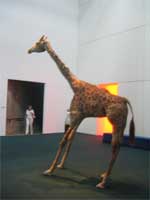
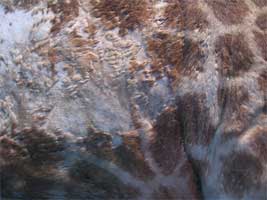
The stuffed giraffe, The Zoo Story (2007), is there to break through the uniformity of the media images and call the attention of the public. The artist sees the giraffe object as an emotional representation of the political conflict in the West bank â" a pars pro toto. Even if you have no clue about what the giraffe stands for you cannot help but feel sad while watching it: the animal is quite tiny and patches of its fur are missing.

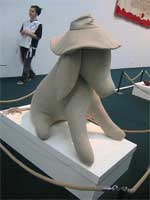
Bit more cheerful is the installation of Cosima von Bonin, Relax - It's only a Ghost (more images). I first thought it was a series of works by different artists but it turned out to be just one work you can walk in. There are oversized stuffed dogs and an octopus, sewn paintings, two pairs of jeans comically "sitting" on some kind of pedestal and two colourful sheet-metal sales carts.
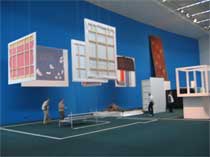
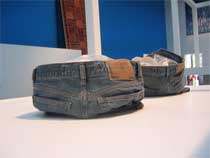
The whole scene is supposed to represent a pirate island in the
Caribbean. Right! Told you i wasn't all that excited.
How to survive the paper industry kicked off the Paper & Pixel week of discussions at Documenta12 in Kassel. The first group of talks looked at the way the development of technology is influencing the publishing process and even allows independent magazine editors to survive. They face the threat created by pixels and toners by reinventing content, technical and economical strategies.
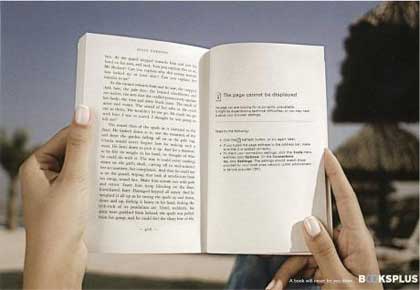
It is precisely the love for the speed of electrons, and an understanding of the potentials of networked media, that have inspired the cultural tactics of these magazines; from print-on-demand, collaborative editing, sharing content and knowledge, to surfing and playing up to new economic donomic demands.
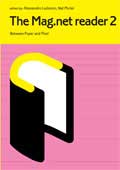 First intervention was by Alessandro Ludovico. Alessandro created the Neural magazine about new media art, electronics and hacktivism in 1993. He is also one of the co-founders of the Mag.net network (Mag.net reader 2, Between Paper and Pixel is out btw!), an advisor to the Documenta12 magazine and one of the hacktivists behind projects such as Google Will Eat Itself and Amazon Noir.
First intervention was by Alessandro Ludovico. Alessandro created the Neural magazine about new media art, electronics and hacktivism in 1993. He is also one of the co-founders of the Mag.net network (Mag.net reader 2, Between Paper and Pixel is out btw!), an advisor to the Documenta12 magazine and one of the hacktivists behind projects such as Google Will Eat Itself and Amazon Noir.
He started by showing the image you can see above, an ad from a book editor that gave the message that books, unlike your computer screen, would never let you down. There is no chance of ever opening a book and finding the message "This page cannot be displayed".
With electronics and digital technology the paper industry knows that nothing will ever be the same again: real time publishing pervading the printed pages, reliability is a value regarded as more and more precious, disembodiment of the paper both on computer and mobile phone screens, etc. Yet, believes Alessandro, the immobility of the paper has something reassuring compared to pixel.
Since the end of the '90s there has been countless announcements that new technologies (electronic paper or e-paper) would replace paper. Yet in 2007, this is still an alien object. Alessandro tested one of these electronic paper readers and he compared the feeling to holding a big palm top. Doesn't replace the pleasure of holding, touching, smelling a book. And it is still quite expensive (around 600 euros).
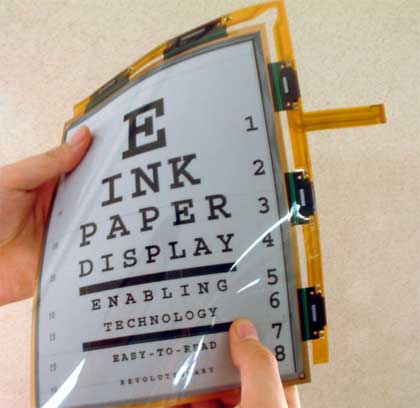
That kind of device would allow users to reduce physical space in their bookshelf while owning more, sharing, copying and storing much more content.
Alessandro then explained how the project Amazon Noir which he developed together with Paolo Cirio and UBERMORGEN.COM exploits the "search inside the book" feature of the online bookseller.
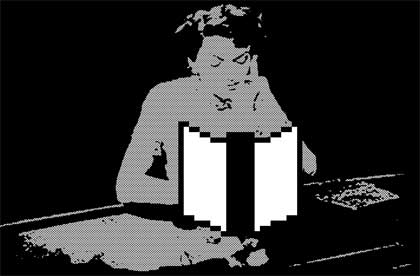
Paper is more persistent that the online text, believes the editor of Neural and publishers are wondering what to do with the web, how to exploit it for their own business. Today the electronic space par excellence is the web.
One of the latest strategies is to give away their magazines for free under a PDF format. A series of glossy, entertaining magazines do that today. They range from Business Week to Premiere. Why? First of all you have to register and by doing so you give them some very valuable information about yourself. Plus, PDF give away improves distribution and augments readership which in turn allows the publishers to sell ad space at a higher price.
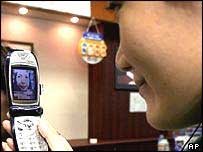 He also recalled the story of "Japan's digital shoplifting plague" which has young girl take camera phone picture of a new hairstyle or a new dress they might spot while browsing a magazine in a shop. They then send the picture to all their friends and comment on it. The publishers of those magazines feel they are being cheated out of valuable sales and have issued posters which warn shoppers to be careful of their "magazine manners".
He also recalled the story of "Japan's digital shoplifting plague" which has young girl take camera phone picture of a new hairstyle or a new dress they might spot while browsing a magazine in a shop. They then send the picture to all their friends and comment on it. The publishers of those magazines feel they are being cheated out of valuable sales and have issued posters which warn shoppers to be careful of their "magazine manners".
Free electronic magazines: either downloadable or simply viewable online. The later strategy is often adopted by experimental publicatins which might want to play with the aesthetics. Ex. Magnify, an underground design magazine which is structured like a standard paper magazine, it has similar graphics, it is not interactive at all, doesn't exploit any of the features offered ny interactive media except the possibility of a wide distribution via the screen. It is like a never born paper mag.
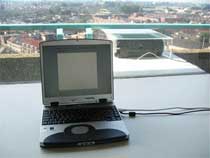
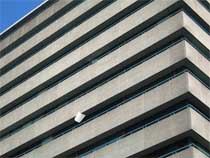
Alessandro showed an art installation called Pamphlet. Helmut Smits. It consists of a laptop, software and a printer placed on the edge of a building window. People can type a message on the laptop, press the 'send' button and a pamphlet with the message is printed and dropped from the 10th floor by the printer. To quote him: "The falling down paper and the resulting 'pamphlet' on the street symbolizes the relatively short distance from the personal production to the public enjoyment of a printed product, and how the traditional product parameters has been disrupted. The fascination of take-away paper is the same at the base of newspapers that are starting to stretch their role and nature with downloadable and printable last minute editions. These are highly customized on one key factor: the updating time. They are meant to be read offline, so enjoyed with a relative calm, but with the most stretched and feverish time of production. This is part of a larger need: to put the virtually and real-time produced content out of the screen to affect real life or be enjoyed in it."
Last part of the presentation engaged with the recent phenomenon of "Print on demand", a printing technology in which a copy is not created until after an order is received. The method allows the publisher to avoid the biggest cost of edition: printing. Any one can send their magazine or book to publish on the web. To Alessandro it is similar to what the photocopy machine was in the '80s: enjoyable and simple just like paper is still today in his opinion.
Read Alessandro's full text. And! there's even a podcast of the whole discussion (via.)
- When you print on a color laser printer, it's likely that you are also printing a pattern of invisible yellow dots.
These marks allow printer companies and governments to track and identify you -- presumably as a way to combat money counterfeiting. When one person asked his printer manufacturer about turning off the tracking dots, Secret Service agents showed up at his - Wooster Collective: Every Image Has A Story - "zbs Hyena Man"
"the original picture comes from a project of the photographer (Pieter Hugo) the title of the project is (The Hyena men of Nigeria) - Medellín’s Nonconformist Mayor Turns Blight to Beauty - New York Times
Cityâs mayor and the son of one of its most famous architects presses forward with an unconventional political philosophy that has turned swaths of MedellÃn into dust-choked construction sites. - weblogart: Synthetic Biology 3
Proceeding of Synthetic Biology 3 is now online ! - BBC NEWS | Health | Tummy fat 'can grow new breasts'
Scientists say they can create a fat mixture with concentrated stem cells, which, when injected into the breast, apparently encourages tissue to grow.
Yo! Here's the third* project born from the Interactivos? workshop held at MediaLab Madrid last month.
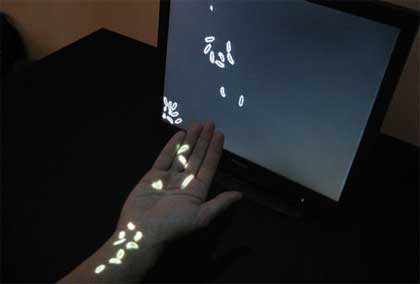
Delicate Boundaries, a work by Chris Sugrue, uses human touch to dissolve the barrier of the computer screen. Using the body as a means of exchange, the system explores the subtle boundaries that exist between foreign systems and what it might mean to cross them. Lifelike digital animations swarm out of their virtual confinement onto the skin of a hand or arm when it makes contact with a computer screen creating an imaginative world where our bodies are a landscape for digital life to explore.
Video.
What was the biggest challenge in developing the project?
The greatest challenge was that the piece dealt very directly with the human body. It was important to create the illusion that these animated forms (which my Spanish colleagues have fondly named
bichitos) have an understanding of the structure of the arm or hand they are exploring and can respond to it in a believable manner.
Interactive works are often facing the challenge of unpredictable audiences and responses, but attempting to respond so specifically to something as versatile and subtle as hand and arm movements was pretty challenging. I also wanted to create the experience that these lifelike forms that are made entirely of projected light had a physical presence in the world. It was certainly a challenge to design a system that convinced people to try to hold them and feel they had perhaps some responsibility for them.
Do you plan to develop the idea any further?
Yes, absolutely. I think there is a lot of potential for development.
The next release of the installation will integrate audio feedback. I began working with several talented sounds designers during
Interactivos?, but did not have a chance to fully integrate it. I think an audio-visual synthesis will add to the sensory experience of the piece. On a more conceptual level, I plan to consider the idea that when two foreign systems or frontiers suddenly connect there is an inevitable change to both. So I am interested to find a subtle, but meaningful way to communicate that.
Looking further into the future, this project explores a lot of the concepts and questions I continue to research during my fellowship lowship at Eyebeam. I am very interested in how digital artists deal with the human body. Although our bodies are so familiar and intimate I think they continue to be a source of mystery (at least to me) and it seems very human to try to use technology to explore and augment them. I also love work that wants to break free from the computer screen or other device, and I think a fascinating way to do this is to treat light as a living or physical force.
How does the system work technically?
The system design is not terribly complex. I use a digital projector mounted over the installation space for the projection onto the body.
A video camera and infrared illuminator are aligned with the projector to perform the vision tracking. The rest of the magic happens in the software which is written in C++ using the openFrameworks library. The program I developed (along with the help of several very talented collaborators) has three main components.
The first connects the various spaces of the installation (the video image from the camera, the projection space, and the computer screen). Understanding how these spaces connect physically was essential in creating a believable transference between the virtual and physical worlds. The next step was processing the live video to find different structural and motion information about the audience and how they are connected to both the screen and to each other. Finally, the fun part was designing the behaviors and interactions. I spent a fair amount of time finding the right marriage of form and physics to give the bugs some character and a sense of life. I have to credit Zachary Lieberman for all his help in programming the physics and motion in the piece.
Thanks Chris!
See also: Light bulb screen and Augmented Sculpture v 1.0.
- ZEMOS98 - Historias de control
historias de control que nos rodean una vez nos adentramos en el espacio público pero que, a un primer vistazo, son invisibles para la mayor parte de los ciudadanos: semáforos, videocámaras, radares, parquÃmetros o altavoces son algunos de los disposi - StrangeHarvest.com::Baltic Exchanged
London's Baltic Exchange - blown up by the IRA in 1992 by a fertilser bomb in a large white truck. Strange story whose resolution sees the old building heading for an unusual retirement. The Baltic Exchange is being rebuilt on the Baltic coast. - selectparks - Marketers pulling out of Second Life
primarily because the 'more than 8 million residents' figure on the gam the game's Web site is grossly inflated. Also regular visitors are not only disinterested in in-world marketing, but actively hostile to it, - Photos of cephalopodic playscapes ::: Pink Tentacle
giant cement octopi posing as playground equipment in Japan. - Archinect : Disappearing Places
Anarchive and collective map of places that no longer exist, at least not as they once did. Users can upload stories and images about a place, link them to a corresponding location or street address and tag them accordingly, as well as browse the stories
My favourite movie ever is L'Atalante by Jean Vigo with the wonderful Michel Simon. Bibi has rescued Zero de Conduite (1933) and a couple of Documentaries by the French movie director.
Merci, merci Bibi!
One of the highlights of the We Love Technology day which took place on July 12 in Huddersfield was the keynote of architect Usman Haque. He titled it "I Hate Technology" and listed several things that bother him about technology. My rough notes:
The word "technology" means something different today than what it used to imply in the past. Technology used to imply "knowledge", it was the study of making. It was not an object but the description of an object. Technology was more about the description of systems. Today we tend to think that technology resides in physical things. That is a rather dramatic change, from the way we describe things to objects containing this thing we call technology.
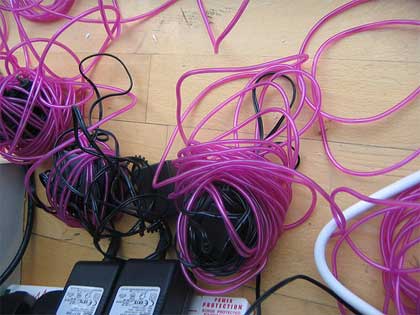
Consequence:
Artefacts. Fetishism for a piece of technology. You would never grab a frog and show it to people saying "this is wonderful biology!" or "Look at this biology!" We have developed a very mechanistic view of technology. Inspired by Steve Jobs?
A second problem is that we have the illusion of progress. When we think about technology, the words that spring to our minds are "innovation, value, efficiency."
But a look at train timetables (from 1973 to 1997) shows that even if loads of money has been poured into the train system, the trains actually got slower.
Example: Going from Portlaoise to Dublin took 51 minutes with steam engine in 1928, in 2006 it takes 55 minutes.
Philadelphia to Los Angeles in 1965 lasted 5 hours and 5 minutes. In 2005, the trip was 6 hours and 1 minutes.
- coin-operated » Mr.T1 - Determine Your Bandwidth Speed With Mr.T.
onstantly checks the current speed of the connected network and if it reaches that of a standard T1 line (1.5mbit/sec) or higher then a Mr.T sound sample is triggered in the form of âI Pity The Foolâ or one of Mr.Tâs other various sayings.
- Behind the Fiendish Complexities of Airfare Pricing
"If fares are atoms, priceable units are the molecules used to build complete tickets." - We Love to Fly and It Shows: Inside the World of Mileage Running
subculture of airline hackers called "mileage runners" who specialize in accumulating frequent flyer miles at low cost. - Eyebeam reBlog: personal powerPlant
a portable device that harnesses electricity through a solar cell and hand crank generator, into a NiMH battery. The device also includes a visual multimeter that monitors the amount of energy stored. The personal powerPlant can be used to power applicati
Another work developed last month at MediaLab Madrid during Interactivos?, a workshop focusing on magic and illusion (see also Augmented Sculpture v 1.0.)
Palimpsesto (video) is a sculpture screen made of "dead" light bulbs. Moving spots of light are projected on its surface and as a visitor comes closer to the screen, the light dots gather and re-create the silhouette of the person. The dead light bulbs seem to come to life again. The presence of a public metaphorically gives back their lost splendor to the bulbs.
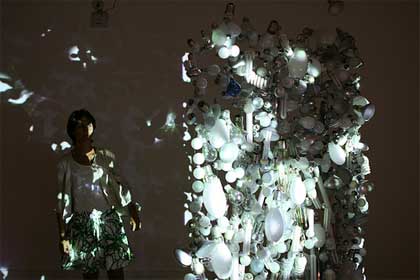
When i visited the workshop, i didn't get to see the installation working. Nevertheless, i found that the screen was really amazing (as was the amount of bulbs that had been broken in the process.) I recently asked Daniel Canogar, the creator of the project, to give us more details about it:
What was the biggest challenge in developing the project?
There were two basic challenges, and i can't quite pinpoint which was bigger. The first challenge was figuring a way of constructing a screen with dead light bulbs in an immaterial way,so that they would look like they were floating. During the installation, many light bulbs were broken, a whole string would come crashing down onto the floor, everyone would stop working and look at me, it was quite dramatic. Eventually I figured out how to do this and there were no further problems.
The second biggest challenge for me was coordinating with the programmer. It was hard to be patient while Jordi, my main programmer who was terrific, typed away for hours trying to get the effects that I was after. In the end he did a terrific job, and was worth the wait.
Do you plan to develop the idea any further?
I consider the piece at the Media Lab a prototype, which is going to be made much larger in the following months. The piece will be featured in a large new media show that is opening in the Reina Sofia Museum in Madrid June 2008, a show called "Maquinas y Almas" (Machines and Soul) curated by Montxo Algora. I plan to develop the piece more with MediaLAb, who have being absolutely amazing to work with. They have a real interest in research projects, and want to take my piece on to develop it more.
How does the system work technically?
When first encountering the sculptural screen made of dead light bulbs, the viewer sees these free-floating white particles flying about. The video projector casts these spots of light on the light bulbs, which makes them look like they magically give light again. When the viewer gets close to the screen, a web-cam hidden amongst the light-bulbs captures his/her silhouette and this information is processed by the Open Frames software and makes the free-floating light particles cluster together. The resulting light-blob loosely has the shape of the viewer's silhouette, and follows him/her as they as they move along. It is the viewer that brings new light to these dead light bulbs, brings forth the memory of these discarded artifacts.
Thanks Daniel!
Image Medialab interactivos.
 Bit slow with the blogging cuz i do not always have access to internet but service should resume as normal from tomorrow on.
Bit slow with the blogging cuz i do not always have access to internet but service should resume as normal from tomorrow on.
Late notice but i hope some of you can come and enjoy a Biorama afternoon in Huddersfield. The event is bringing together artists who explore notions of life, science and digital realities.
This morning Andy Gracie (hostprods), currently in residency at DRU, and Brandon Ballangee will take us for a hike around Marsden Moor, traditional and digital networking systems, satellite communications, perceptions of landscape and the history and possible future of interstellar communication. The walking talk will cover the parallel conceptual territories including the topography of local transmission masts, the history of interstellar communications, the landscape painting tradition and the micro ecology of the moors. Simple scientific field experiments and samplings will be carried out at various points on the way which will provide a window on the methodologies and concepts which Andy has been attempting to weave together throughout the residency.
The Biorama Sessions are free and open to the public. They will start at 3.30 p.m. at the Media Centre.
In each session, two artists will present their work and explore common territories before brief open discussion.
Participants: Agnes Meyer-Brandis, Andy Gracie, Brandon Ballengee, C-Lab, etoy, France Cadet and London Fieldworks.
Image: Brandon Ballengée, Green frog (Detail).
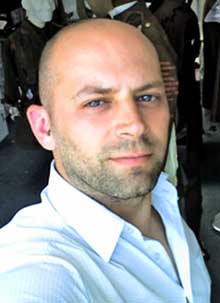 Back in 2004, i stumbled upon a project called The Face Corset. Designed by Paddy Hartley to simulate the effects of cosmetic surgery, they were one of his first comments on and explorations of cosmetic surgery and our culture's obsession with beauty. Furthermore, the artist collaborated with Biomaterials Scientist Dr Ian Thompson to adapt the corsets into facial dressings that could protect and support the face during the recovery period after surgery or skin grafting.
Back in 2004, i stumbled upon a project called The Face Corset. Designed by Paddy Hartley to simulate the effects of cosmetic surgery, they were one of his first comments on and explorations of cosmetic surgery and our culture's obsession with beauty. Furthermore, the artist collaborated with Biomaterials Scientist Dr Ian Thompson to adapt the corsets into facial dressings that could protect and support the face during the recovery period after surgery or skin grafting.
With Project Facade, the second step into this research, the artist is looking into the personal and surgical stories of soldiers who, disfigured in battle during the First World War, had to undergo pioneering surgical reconstruction. "The very nature of trench warfare, moreover, proved diabolically conducive to facial injuries: "[T]he...soldiers failed to understand the menace of the machine gun," recalled Dr. Fred Albee, an American surgeon working in France. "They seemed to think they could pop their heads up over a trench and move quickly enough enough to dodge the hail of bullets." (via)
Working from original patient and surgical notes along with personal family archive material of the men, Hartley designs, modifies and embroids uniforms similar to those the servicemen fought in. Each garment tells the fragmented personal history of a man who had to go back to his families with a seamed and shattered face.
Working in partnership with Gillies Archive Curator Dr Andrew Bamji at Queen Mary's Hospital Sidcup and Dr Ian Thompson at in the Oral Maxillofacial Dept, Guys Hospital London, the project allows Hartley to examine and respond artistically to the origins of surgical facial reconstruction, compare current techniques in facial surgery and the development and implementation of bioactive materials for the repair of facial bone injuries.

Victor T.
What prompted your interest in the origins of surgical facial reconstruction techniques?
Even though I trained in ceramics and sculpture, I've always been more interested in human biology, technology, and engineering, that sort of thing than in art. I see the Artistic/creative process as a vehicle for the examination and combination of âanything with everythingâ. So much of the work I produced at University and in my early career was about anything other than âArt or the Artistâ. Examining the use/abuse of Steroid in bodybuilding, religious organizations shifting attitudes towards medical technologies and recently the origins of facial reconstruction.
Having seen some of my previous work using medical equipment, I was invited by the Victoria & Albert Museum in London in 2002 to exhibit work for an evening-long event called âShort Cuts to Beautyâ which consisted of a series of public demonstrations, presentations and debates on âbeauty industriesâ and their impact on society today. Not having anything appropriate for the event in my back catalogue, I proposed I make new work for the event and considering one of the topics up for discussion was extreme cosmetic surgery and the use of facial implants, it seemed appropriate to make work based around a hypothetical of facial surgery as taboo. What if it was considered taboo in todayâs society to alter the structure of the face surgically for cosmetics alone? How could an individual radically alter the structure of the face without the use of surgery? Corsetry immediately sprang to mind (particularly as I left the V&A after my meeting I left via the Dress Gallery and saw the collection of corsets on display). If it was possible to alter and âtrainâ the structure of the body with a garment, could I do the same with a âfacial corsetâ to shift the soft tissue of the face?
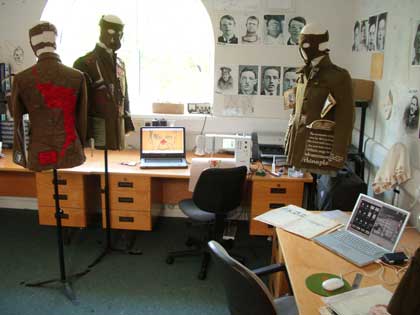
Paddy Hartley's studio
So having never even sat at a sewing machine, I set about making patterns based on my own face (the only one readily available!) and getting to know the basics of garment construction. The original idea was to make âneutralâ looking garments from white fabric incorporating external âadornmentsâ using commercially available facial implants. This was how I came to meet Biomaterials Scientist Dr Ian Thompson at Imperial College London via recommendations from the Science Museum, London. I originally approached Ian to try and obtain some commercially available facial implants but when I saw the work he was doing making Bioactive glass facial implants for the repair of bone facial injuries, I thought I just had to incorporate these into the âFace Corsetsâ, which as it turns out, we did. As far as the Corsets themselves were concerned, an unexpected (yet with hindsight totally foreseeable outcome) was that the tighter the garment was fixed to the head, the more the wearer was able to reposition the exposed skin.
The presentation of the work at the V&A event really was the start of a long working relationship between Dr Thompson and myself. My skills in developing the casting of the implants with Ian coupled with his vision of the âFace Corsetsâ as potential pressure dressings cemented our working relationship and the logical next step was to seek funding to pursue our collaboration. Obtaining our first grant from The Wellcome Trust allowed us to develop the work full-time for a year but if the truth be known, quite early in the project my interest turned to the origins of facial reconstruction.
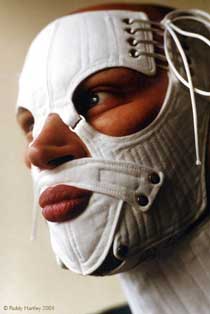
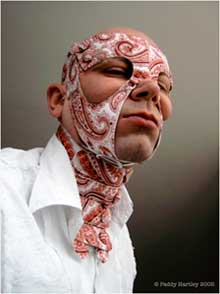
First Face Corset and Paisley
How has the public reacted to the Face Corset when you exhibited the work?
Very mixed, sometimes with a raised eyebrow, sometimes with a knowing look, sometimes with a chuckle. Everyone brings their own interpretation which, to a certain degree is great because I didnât intend to load the work with meaning. They are physical devices built around a âfunctionalâ brief. What I have found though is that the majority of people see a facial garment as a device to hide the face, often referring to the Face Corsets as Face âMasksâ. As I see it a mask is intended to hide the identity of the wearer whereas the Face Corsets are intended to alter the appearance of the wearer by manipulating the skin of the wearer. The intention is do âdisplay the wearer in a different wayâ.
Many people seem to assume that a facial garment has some kind of sexual connotation. I tell you, the amount of enquiries I've had from PVC clad âexoticsâ looking for a bespoke PVC Face Corset. Thatâs not my scene and not why I made the work, which is why I've never sold or given a piece away. I donât want to be responsible for making something that could cause physical harm to a wearer/user. There did come a point where I decided to make the Face Corsets out of fabric as far removed from the S&M scene as I could imagine. I used old suit material, my old shirts, that kind of thing but regardless, the facial locating of the Face Corsets was still read by viewers and having aesthetics which alluded to a sexual/menacing/disguising. This is why I âburiedâ the Face Corsets.
What exactly are the Bioactive© glass facial implants you mentioned earlier?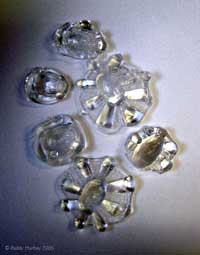
The implants are made from a special glass that contains a combination of other components that make the glass less prone to rejection by the body. Bioactive glass was invented by Prof Larry Hench as a material to repair massive bone injuries of US servicemen injured in the Vietnam War. Even though the Bioglass© in a powdered/paste form did bond bone fragments, the material was not load bearing. Dr Thompson (Ian) has recently been casting the glass into small monolithic forms to repair non-load bearing bone injuries, particularly of the face. When I came on the scene, Ian was by his own admission using fairly primitive casting and carvind carving methods. The skills I acquired in mold making and casting I picked up at University and at a later post in bronze casting foundry enabled me to work with Ian to try out new lost-wax casting techniques for the production of patient specific implants. Since then, the production methods of the implants have advanced and this element of the collaboration has run its natural course.
For âProject Façadeâ you collaborated with Dr Andrew Bamji, Consultant Rheumatologist and Curator of The Gillies Archives, and Dr Ian Thompson from the Department of Oral Maxillofacial surgery at King's College. How did you get to work with scientists?
Itâs always the ideas for the work I make that lead me to meet the people I work with whether they be Dress Historians at the V&A, Scientists at University Hospitals, Family Historians based at the National Archives at Kew or Army Surplus suppliers in Portsmouth. I donât have a specific desire to work with scientists, thatâs just the direction the work has taken me.
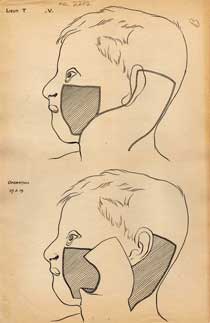

Top V: Sketch proposing grafting skin to replace scarred cheek and Skin from tubed pedicle 1. in place on chin and nose.
How difficult has it been to trace the records of men injured and disfigured during the First World War? Can you tell us the story of one of those injured Servicemen that you found particularly touching/interesting/meaningful?
In so far as tracing the medical records, this was pretty straightforward. When I first became interested in finding out more about the origins of facial reconstruction, I recalled seeing a very short clip of an interview on a TV documentary which mentioned the pioneering surgery developed by Sir Harold Gillies during the First World War to repair horrific facial injuries. A web search brought the Gillies Archive to my attention so I booked an appointment to meet the Curator Dr Andrew Bamji (who was the chap on the TV documentary) and see some of the records. On first sight I was overwhelmed by the amount of material Andrew had collated. The Archive holds somewhere in the region of 2500 documents recording with photographs, pre-op sketches, plaster casts and handwritten notes, the surgeries the patients underwent under Gillies.
I was originally drawn to the Archive because of an interest in the surgery yet I found myself becoming incredibly curious to find out more about the post-surgery stories of the men treated by Gillies. However, only a handful of the records Andrew has collated tell the pre-injury and post-surgical stories of the men and this is largely due to Gillies patients sending him photographs and letters to let him know how they were getting along in life.
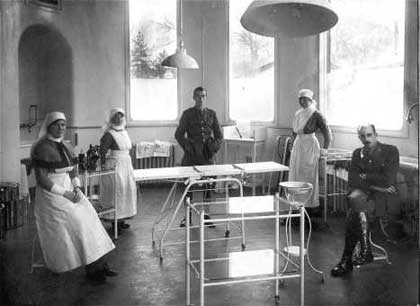
The Plastic Theatre, Queen Mary's Hospital, 1917. Harold Gillies is seated on the right (image reproduced from the Gillies Archive)
I was keen that the work I was embarking on making didnât just tell the surgical stories of individual men but the personal stories also. I didnât want the men to be defined by their injury and subsequent surgery. So once I had selected a small group of men whose stories I would like to tell, I employed Genealogist Elizabeth Evans to take the information we had and on the 10 men I had selected and search the archives at the National Records Office at Kew to see what additional information we could find. Some of the men had very little information other than census records and Regimental war diary entries by their Commanding Officers. Others however had details on the menâs trade before joining the Armed Forces, details of family members and in one case in particular, personal letters from nursing staff pleading with higher ranking officials for patients to be admitted to the plastic surgery unit at Sidcup for their facial injuries to be treated.
There are so many stories that have emerged over the past two years its hard to say which has touched me the most. Willie Vicarage the Welsh watchmaker who was so badly burned in the Battle of Jutland he lost most of the skin from his face, his nose, parts of his ears and almost all of his fingers. Alfred Russell who received skin grafts from his buttocks to his cheeks. Alfredâs wife Florence would joke that when kissing him on the cheek she was actually kissing him somewhere else! Itâs the story of 2nd Lieut Henry Ralph Lumley that really got to me.
Henry, son of Robert and Florence and elder brother of Molly was a well-educated young man working for the Eastern Telegraph Company. Having not being a member of the Officer Training Corps Henry went out of his way to train as a pilot sought special permission to do so for which he was granted and attended Central Flying School, Upavon from 15th April 1916. The first tragedy to strike was on the very day Henry graduated from flying school when his plane crashed and he suffered horrific facial burns. A letter from Central Flying School to his mother stated on the same page that her son had graduated and that his aircraft âmet with an accidentâ.
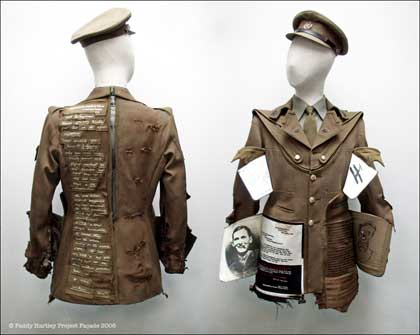
Lumley
Roughly a year after his crash, Henry was transferred to Sidcup for reconstructive surgery under Gillies who proposed removing Henryâs badly scarred face entirely and replacing it with a single, huge skin graft taken from Henryâs chest. A similar less extensive procedure had proved highly successful for the aforementioned Willie Vicarage a month earlier. Henryâs surgery was more ambitious and partially due to Henryâs weakened condition the graft rejected and Henry died a few days after his surgery.
Gillies continued to encounter similar injuries to pilots and sailors and as a result of the failure of Henryâs surgery; Gillies began repairing full facial burns in stages, thus giving the patient chance to recover between surgeries. Henryâs death brought about an entire reassessment as to how to treat such injuries and hundreds of patients benefited from what was learned from Henryâs tragic surgery and paved the way for the highly successful skin grafting surgery performed on the self styled World War 2 pilots âThe Guinea Pig Clubâ over 25 years later.
As a result of the record search, I discovered Henry was buried close to my home so I took iI took it upon myself to visit his grave. Something I never envisaged doing at the beginning of the project. Tucked away in Hampstead Cemetery is a small family headstone naming his mother, father and sister along with Henry. Sitting by Henryâs headstone for a couple of hours and being physically that close to him made me realize this was more than just âa projectâ to me. Here were stories about incredible people that needed to be told.
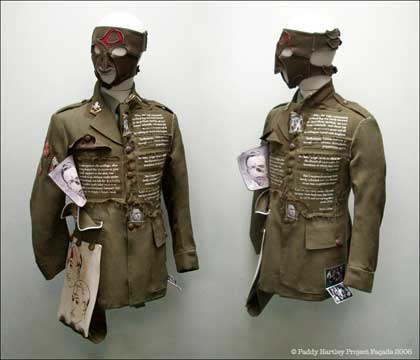
William Spreckley
For Project Facade you are creating a series of garments. What are you trying to achieve or communicate with these pieces? How do they complete or respond to your previous work, The Face Corsets?
The main aim of the work initially was to communicate an understanding of the pioneering surgery Gillies performed on his servicemen patients. Now though it is more about telling the stories of the people who underwent this surgery, who they were, how they came to be injured, illustrate the surgery they underwent and how they dealt with the physical and psychological consequences of receiving this surgery. Iâm very much a believer that âyou wear your history on your faceâ, particularly with these men. The military uniform, itself a record of the wearers military service, seemed a perfect vehicle to tell these fragmented âpatchworkâ stories. Gillies patients ended up âwearingâ their military history on their faces for the rest of their lives. The uniform sculptures and accompanying face garments pool all the information I have from a variety of sources to present a collage of experience of that individual. The facial garments made from identical fabric as that of the uniforms represent the military history being worn on the face and act as an anchor point for the illustration of movement of skin by Gillies from other parts of the body to the face. I was keen that the work did not replicate injury. That in my opinion would be crass.
As far as Iâm concerned, if the work I make merely provokes viewers to want to find out more about these amazing heroic people and acknowledge their sacrifice, it has been successful.

Walter F.
Did the fact that you have spent several years working on this project changed the view you have on your own appearance, the fact that cosmetic surgery is getting mainstream and (if you have any) beauty ideals?
Actually yes. In my youth I was something of a âpeacockâ. Because of the last couple of years work, I donât worry about putting on a little weight, the dark circles under my eyes, my slightly less elastic skin. This is just how I am. Iâm more concerned that my back doesnât work quite as well as it used to. I must say though, the plethora of cosmetic surgery TV shows really makes my blood boil I just wish a fraction of airtime was given over to tell the stories of the servicemen Gillies treated to restore function to their faces as is given over to people having the fat sucked out of their backsides.
Speaking personally, my beauty ideals tend to be personality based but if we are going to get superficial, I do like ladies with gaps between their front teeth that speak with a lisp and a top lip that looks like its been smeared flat! I find difference attractive.
What can members of the scientific community learn from your own artistic research?
Speaking very generally, to be open to collaborate across disciplines, but that goes for anyone in any profession, but not to âforceâ the collaboration. Let it take you where it will. Fellow artists have asked me on a number of occasions as to how they can have their work taken on board as part of clinical practice in health care and my answer never changes. âI donât know!â That has never been an aim of the work I set out to do. If it contributes towards clinical practice by proxy, thatâs great because its evolved naturally rather than by design. As far as Iâm concerned the main audience I want to connect with is the general public. Essentially thatâs who the work is about.
Any upcoming projectâs that you could share with us?
Project Façade Phase 2. Iâm trying to trace as many descendants of Gillies patients to record their memories of their âGillies repairedâ relatives to find out and preserve their later life experience. This has becoming a life long undertaking for me.
Thanks Paddy!
All work produced by Paddy Hartley and associated Gillies Archive documents and objects can be seen at the first Project Façade exhibition âFaces of Warâ produced with and opening in Autumn 2007 at The National Army Museum, London.
For further details contact Paddy directly on paddyhartley at projectfaçade dot com or visit the project website to find out more about the stories of the men and Paddyâs responses.
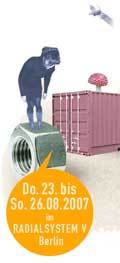 Off to Zürich for the Digital Art Weeks symposium and a very yummy-looking exhibition. After that i'll be in Huddersfield for We Love Technology, this year the event will focus on interactive architecture, sound and games.
Off to Zürich for the Digital Art Weeks symposium and a very yummy-looking exhibition. After that i'll be in Huddersfield for We Love Technology, this year the event will focus on interactive architecture, sound and games.
Then back in Germany. First in Kassel for, Paper and Pixel Week, a series of workshops and debates on the relationship between online and offline press, as part of Documenta's Magazine Project. The event is curated by our friend and guru Alessandro Ludovico. Then hop on the train and off to Dortmund for the Satellite Voyeurism workshop at the HMKW. Looking forward to that one too.
Say hi if you're around.
After that i'll spend some time in the most boring country ever because i need to get some rest from the constant excitement that Berlin provides me with. I'll watch tv series, try some new blueberry face masks and read detective stories. That's called holidays and i won't be back in Berlin before the 9to5 festival-camp in August. I didn't exactly get what it is about (alternative forms of works maybe?) except that it takes place from 9 in the evening to 5 in the morning, that everyone will be talking german but me, and that it is organized by the lovely Holm Friebe and when that guy asks you to "relocate your whole business" on the banks of the river Spree, you just follow the advice.
Lise Lefebvre recently graduated from the Design Academy Eindhoven with a lovely project which deals with sound in domestic appliances.
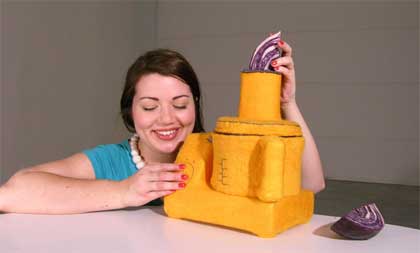
Weâre surrounded by objects that create noise as a by-product of their function, affecting our health and quality of life.
What if sound became a criterion for design? What would be the effects it could have on the look, feel, texture and overall experience of an object?
Lise´s handfelted domestic appliances are audibly, but also visually silenced. The fabric absorbs most of the sound coming from the motors. As Lise wrote me "the little objects in particular seem to be purring very gently."
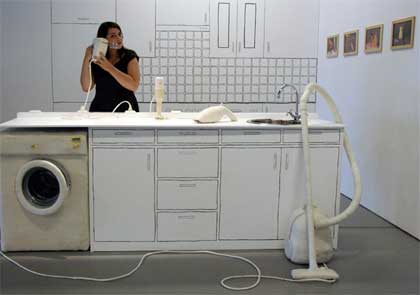
Pictures by Sander Lucas and Hans Tan.
More domestic appliances: Dancing appliances, music from the kitchen, The Turnatable Microwave, Your head inside the washing machine, Manolo is gonna have fun, In the Kitchen, VJ Sewing machine, Machine therapy, etc.
 The Port Huron Project is a series of reenactments of protest speeches from the New Left movements of the 1960s and '70s. Each event takes place at the site of the original speech, and is delivered by a performer to an audience of invited guests and passers-by. To reach a wider audience, videos of these events are distributed on DVD and posted online. The project is named after the Port Huron Statement, the manifesto of the Students for a Democratic Society (SDS), a student activist movement formed in 1962.
The Port Huron Project is a series of reenactments of protest speeches from the New Left movements of the 1960s and '70s. Each event takes place at the site of the original speech, and is delivered by a performer to an audience of invited guests and passers-by. To reach a wider audience, videos of these events are distributed on DVD and posted online. The project is named after the Port Huron Statement, the manifesto of the Students for a Democratic Society (SDS), a student activist movement formed in 1962.
The first event in the PHP series, Port Huron Project 1: Until the Last Gun Is Silent, took place on September 16, 2006 and was based on a speech given by Coretta Scott King at a peace march in Central Park in 1968.
The next re-enactment will take place on Saturday, July 14, 2007, at 5 p.m. in the Boston Common park, an actor will deliver a speech given by Howard Zinn at a peace rally in May 1971. Zinn was arguing for the necessity of civil disobedience to protest the war in Vietnam and called on Congress to impeach the president and vice president of the US for the âhigh crimeâ of waging war on the people of Southeast Asia. The performance, titled Port Huron Project 2: The Problem is Civil Obedience.

The Port Huron Project is organized and curated by Mark Tribe, i asked him a couple of questions about the projects:
Why do you think it is important to reenact protest speeches from the '60s and '70s? Is our decade not protesting enough? Have we lost something?
I think we have a different, and perhaps diminished, sense of what's possible today compared to the '60s. In his speech at the March on Washington in 1965, Paul Potter talked about changing the system. We protest the war in Iraq, or the WTO, but it's hard to imagine that we could really change things in a radical way: put an end to the military industrial complex, replace consumer capitalism with another form of economy, or achieve true democracy. Back then, people seemed to be able to imagine a radically different future. I think it's vitally important that we recapture some of that utopian spirit.
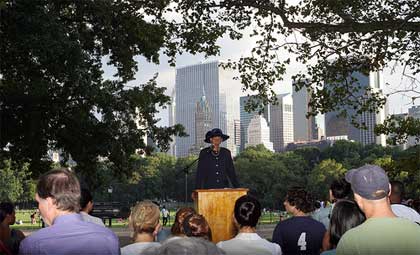
How do you choose the speeches you are going to reenact? Do they have to echo a particular current event or is the choice driven by other reasons?
Most of the speeches talk about Vietnam and link it to domestic issues such as poverty and racism. I do see uncanny parallels between Vietnam and Iraq, and although more progress may have been made on social justice and liberation, those issues are very much alive today. So in choosing speeches to reenact, relevance is definitely a big factor. Other considerations are the quality of the speech and the location--for the purposes of this project, they have to have been delivered at a public protest.
Thanks Mark!
A list of historic protest speeches has been compiled.
Related: The exhibition History Will Repeat Itself currently running at the Hartware MedienKunstVerein in Dortmund focuses on current strategies of re-enactment in contemporary (media) art and performance.
Image 2 via newsgrist.
Blogged by Hack41
. . . . . . . . . . . . . . . . . . . . . . . . . . . . . . . .

0 Comments:
Post a Comment
<< Home